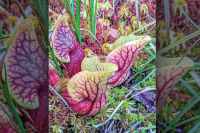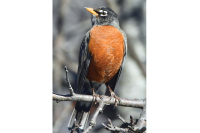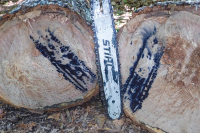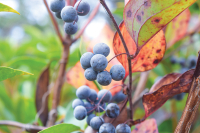If you build it they will come: Haywood County livestock center becomes crucial aid distribution hub
 Tons upon tons of hay have cycled through the livestock center. Kyle Perrotti photo
Tons upon tons of hay have cycled through the livestock center. Kyle Perrotti photo
Dan Messer would have preferred to host a livestock auction on Monday, but instead he was working one in a string of countless dawn-to-midnight days coordinating aid distribution out of the WNC Regional Livestock Center in Canton.
It’s not that Messer, a Haywood County native who runs the day-to-day operations at the livestock center, isn’t honored to serve his community during a time of extreme need. Of course he is. But as Messer is quick to admit, he didn’t expect to become the man in charge at the hub that receives and distributes most of the feed and hay to desperate farmers still cut off from access to these vital supplies.
A running joke among the dozens of volunteers is the absurd frequency with which someone somewhere is asking, “Has anyone seen Dan?” Of course, because the man is always on the move somewhere around the property, no one ever knew for sure. You’d just have to find him. In fact, at some point, someone made a button that reads “No, I don’t know where Dan is.”
“It’s a lot … I didn’t ask for it to start,” Messer said. “At times it’s a nightmare.”

Dan Messer has been in high demand in recent weeks, and this button has emerged as a sort of inside joke. Facebook photo
But the need following a disaster like this is great, especially this time of year when many people are looking forward to a crucial month during which animals can still feed off pastures. However, many pastures are now wiped out or at least contaminated. Come next year, that land will need to be tilled, and new grass must be planted. Meanwhile, instead of looking at three months or so — a typical winter season — when animals would have to eat hay, now it may be the better part of a year.
Related Items
Messer technically started the operation in the days ahead of Helene’s arrival as heavy rains from a separate system caused rivers to swell ahead of the hurricane. At that time, Messer put out a call for people looking to temporarily keep their animals at the livestock center. Not a lot of people took him up on the offer, but that was just the beginning. Within a week, the sales arena at the livestock center was loaded with supplies and the whole building was being used as the receiving and distribution hub coordinating with the state Department of Agriculture for livestock distribution.

Dan Messer has coordinated the effort on the ground. Kyle Perrotti photo
Although the pens normally used to hold animals awaiting their run in the sales arena haven’t held much livestock in the weeks following the flood, they are packed with tons upon tons of all kinds of feed. And that’s in addition to the dozens of round bales and hundreds of square bales of hay at the south side of the building.
The whole thing morphed several times as it grew, and what started as an effort to provide for people who couldn’t provide for their livestock in the wake of the storm now coordinated deliveries of medication and oxygen, tents and sleeping bags, clothes and food. Initially, the effort was supposed to mirror what Messer and volunteers put forward in 2021 following flooding in Cruso and Canton caused by Tropical Storm Fred. However, Messer said what is happening now at the livestock center dwarfs what was seen in 2021, and it seems to just keep growing.
Logistically, it makes sense to run such an operation out of the WNC Livestock Center. It’s right off Interstate 40, which although severely damaged to the west, provides ubiquitous access from the east. It is large enough to house the massive lode of supplies. It has more than enough grassy space to accommodate a Chinook bringing in hundreds of pounds of feed or hay.

This photo of hay being offloaded from a Chinook helicopter went viral on the WNC Regional Livestock Center’s Facebook page. Facebook photo
In this case, because of the magnitude of the disaster and the large area affected, nonprofits such as Fleet of Angels and The Sanctuary at Red Bull Run took note of the operation at the WNC Regional Livestock center and started routing donations there. The immediate effect of that organic growth was that it brought in volunteers from that world, such as Kat Dortenzo.
Dortenzo came to the mountains from the Atlanta area. She’d met her husband in Asheville and lived in Fletcher for a while, so she has some connection to the area. Perhaps more important for this mission, she has plenty of relevant experience. Along with growing up on a hay farm in Michigan, she is also a professional horse trainer and works with multiple nonprofits in that field. She learned of the work being done at the WNC Livestock Center when she heard about a local hay-donation effort.
“I was just sitting at home saying, ‘what can I do to help?’” Dortenzo recalled.
Dortenzo arrived about a week and a half after the flood and stayed through the end of last weekend. Like many of the other volunteers, she was camping out on the hill above the sales barn. During the daytime, her role has been working with people looking to bring in large donations of hay and feed.
“Every day I’m coordinating with people and working to get stuff up here,” she said.
Within a week of floodwaters receding, people on social media took note of the WNC Regional Livestock Center as several posts went viral, including one of volunteers unloading hay from the back of an Army Chinook helicopter that has been shared almost 10,000 times. It was this newfound viral popularity that brought volunteers from far and wide looking to do whatever they could to help.
One night, the Wednesday after the storm, a woman drove in from Fayetteville but didn’t arrive until about 11 p.m. She asked to pull her vehicle around to the grassy hill behind the area where she could get some sleep. She stayed there for three days as she worked, and the area became somewhat of a makeshift campground. Some volunteers from other states have camped out in that area for the better part of two weeks.
Along with volunteers coming from all over, unsolicited donations began pouring in, and now, from sunup to sundown, a line of trucks hauling hay, feed and human supplies is seen that runs from the receiving area of the facility all the way down to the road below.
Once the supplies arrive at the livestock center, they are sorted out and quickly turned around and shipped to smaller receiving hubs, often at community centers, from which they are distributed to 26 North Carolina counties, including and especially those hardest hit by the storm. Because some places are cut off, some of those supplies have to be hauled in by ATVs or even mule teams.

Mule teams have been brought in to reach some of the hardest hit areas. Facebook photo
“The coolest part about this entire thing is 100% volunteers,” Messer said, adding that those with the Department of Agriculture he’s worked with have also been great.
While Messer has acted as a sort of foreman overseeing the operation on the ground, Yvonne Coburn has masterminded the whole effort, coordinating logistics from behind a wobbly plastic desk littered with papers, energy drinks and cell phones. Behind her is a white board with locations and pending deliveries. While the whole thing may seem chaotic, Coburn has calmly kept track of everything in her ledger.
Coburn is the founder of the Civilian Disaster Response Organization, which aims to provide hay, feed and other necessary supplies to people with livestock in the wake of a natural disaster. Many of those in need following disaster have small operations, and some are simply homesteaders with a family cow, some goats and a chicken coop, but Coburn realizes that these animals may even be more important to those folks than bigger operations. Coburn said the goal is to get people and animals the things they need where they are, and there’s a good reason for that.
“We believe in sheltering in place. Studies have shown that if you can safely shelter in place livestock, then it is least traumatic to them because they’re in a place that they’re familiar with,” she said.
Like Messer, Coburn has been blown away by how their operation has grown.
“We started off with just a focus on livestock, and we’ve just worked up to the point that it it’s kind of like a mega church,” she said. “This has exceeded anything Dan and I could even dream of.”
Coburn also receives volunteers, many of whom hope to go out on ATVs and find some adventure while providing aid. In most instances, those people are asked to stay right there at the facility and take a hands-on role with either receiving or distributing supplies.
“We don’t do the sexy stuff, but we do the necessary stuff,” she added. “Cajun Navy does the sexy stuff. They ride around ATVs and they rescue people. Not to down the Cajun Navy, because we have worked with them in this event, and they’ve been phenomenal to us, but that’s not our mission.”
Along with Messer, Coburn is one of two people who vets anyone involved with any element of the process. When it comes to volunteers, that can be as easy as sizing them up and considering where they could be best utilized. When it comes to people offering to move hay, feed or anything of value like meds or generators, that can go a bit deeper. Perhaps most important is vetting farmers who say they’re in need to see what they could use.

Yvonne Coburn has been the brains behind the operation and has kept track of what’s coming in and what’s going out. Kyle Perrotti photo
At this point in the overall relief effort, human aid is flowing well across every community, and the livestock center has more water and certain food and hygiene products than it can take, so they are turning away such donations. However, the calls for feed, hay, generators and chainsaws are still constant, and there is a dire need for both temporary and permanent fencing materials in areas that experienced the worst flooding.
This was echoed recently in a press release sent out by North Carolina Agriculture Commissioner Steve Troxler.
“We have seen time and time again our agriculture community support one another in times of need, and this is no different,” he said. “We are seeing an outpouring of support with hay, animal feed, fencing and other supplies that are going out to those needing these resources. In the days ahead, we know we are going to need even more fencing supplies, especially solar fence chargers to help livestock producers. If you have resources to donate, please go to our website to let us know.”
These needs don’t appear to be going away any time soon. While Coburn and Messer are exhausted and at times frustrated with how big the operation at the WNC Regional Livestock Center has grown, they are keeping their eye on the mission they care so deeply about.
“Apparently it was God’s plan, because it came to us,” Messer said. “But it’s worked, and the people that needed to be here have come, and they’ve all done absolutely incredible job. I didn’t set anybody up at the gate. I didn’t send anybody anywhere. They’re just falling into place. Everybody’s doing what they do. It’s like a force of nature. It’s passion and it’s compassion.”

Want to help?
The direct link to the Disaster Hay and Livestock Assistance Portal is go.ncsu.edu/livestockdisasterhelp. The form asks if you need help or want to help. To donate click on the ‘Want to Help’ button, then you will be asked for contact information and items you have to donate.
Fencing items can also be brought to the WNC Regional Livestock Center at 474 Stock Drive in Canton. Here is a list of items most needed at this time:
• Chicken feed
• Hog feed
• Braided horse tape
• T posts
• Barbed wire
• Smooth 14-gauge wire
• Woven wire
• Hight tensile wire
• Solar chargers













